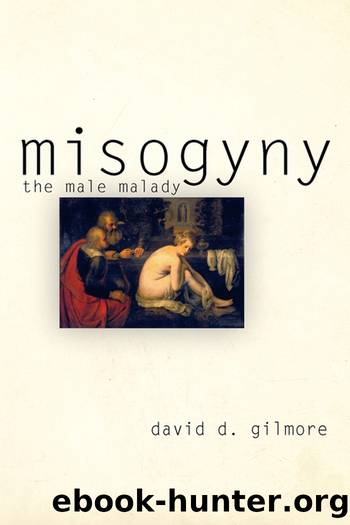Misogyny by Gilmore David D.;

Author:Gilmore, David D.;
Language: eng
Format: epub
Publisher: University of Pennsylvania Press
Jungle Queens and Serpents
The theme of the evil seductress luring man into the primitive past finds rich expression in late nineteenth-century English adventure novels, especially those involving explorers on the Dark Continent. In this genre, authors intertwine those dual Victorian icons of primitivismâwoman and darkest Africaâinto flamboyant images of female perversity. Such hybrid tropes flourish profusely in novels like Joseph Conradâs Heart of Darkness (1902), H. Rider Haggardâs She (1887), and various âTarzanâ works by Edgar Rice Burroughs. In these fantasies African women are used as metaphors for bestiality, licentiousness, and regression. For example, Conradâs powerful novella, which is about civilized manâs descent into chaos and savagery in the colonial Congo, conjures up the spectacular vision of a savage native woman, the embodiment of the call of the wild. His vivid description is worth quoting in full:
She walked with measured steps, draped in striped and fringed cloths, treading the earth proudly, with a light jingle and flash of barbarous ornaments. She carried her head high; her hair was done in the shape of a helmet; she had brass leggings to the knees, brass wire gauntlets to the elbow . . . bizarre things, charms, gifts of witch-men, that hung about her, glittered and trembled at every step. . . . She was savage and superb, wild-eyed and magnificent; there was something ominous and stately in her deliberate progress. And in the hush that had fallen suddenly upon the whole sorrowful land, the immense wilderness, the colossal body of the fecund and mysterious life seemed to look at her, pensive, as though it had been looking at the image of its own tenebrous and passionate soul. (Conrad 1983: 100â101)
In this vision, woman and brute nature are one. The barbaric Black Woman is the symbol of Africa, which is in turn the embodiment of the overripe rendered throughout in the idiom of pathetic fallacy.
The Jungle Queen extends her arms invitingly to the narrator, Marlowe, inviting him to join her in celebration of the lustful animality of the jungle. Distantly glimpsed amidst rotting vegetation, the archetypal siren represents all that is eerie, uncanny, atavistic: that which is beyond understanding, the Dark Continent itself, unknown rites, the occult, tropical fecundity, cannibalism, savagery. As Marianna Torgovnick says, the circularity between the concepts âfemaleâ and âprimitiveâ is so complete in Conradâs work âthat it is difficult to tell which set of tropes influenced whichâ (1990:156).
H. Rider Haggard in his fantasy novel She also creates an African totem-queen to symbolize the sinuous, sinister forces of nature. (Both Freud and Jung thought the two-thousand-year-old heroine perfectly epitomized the feminine impulse in nature [Dijkstra 1996:95].) The nameless goddess is referred to symbolically as âShe Who Must Be Obeyed,â thus implying a tyrannical feminine archetype reminiscent of primitive matriarchy myths and Bachovenian anthropology. With reptilian imagery predominating, âSheâ is presented as something between human and animal. The majestic âSheâ is a tall, beautiful woman, but, as the narrator says, âwith a certain snake-like grace.â She is described as not only
Download
This site does not store any files on its server. We only index and link to content provided by other sites. Please contact the content providers to delete copyright contents if any and email us, we'll remove relevant links or contents immediately.
Cecilia; Or, Memoirs of an Heiress — Volume 1 by Fanny Burney(31333)
Cecilia; Or, Memoirs of an Heiress — Volume 3 by Fanny Burney(30934)
Cecilia; Or, Memoirs of an Heiress — Volume 2 by Fanny Burney(30889)
The Great Music City by Andrea Baker(21313)
We're Going to Need More Wine by Gabrielle Union(18073)
Bombshells: Glamour Girls of a Lifetime by Sullivan Steve(13108)
Pimp by Iceberg Slim(12931)
All the Missing Girls by Megan Miranda(12749)
Fifty Shades Freed by E L James(12451)
Norse Mythology by Gaiman Neil(11883)
Talking to Strangers by Malcolm Gladwell(11879)
Crazy Rich Asians by Kevin Kwan(8349)
Mindhunter: Inside the FBI's Elite Serial Crime Unit by John E. Douglas & Mark Olshaker(7834)
The Lost Art of Listening by Michael P. Nichols(6474)
Enlightenment Now: The Case for Reason, Science, Humanism, and Progress by Steven Pinker(6405)
Bad Blood by John Carreyrou(5769)
The Four Agreements by Don Miguel Ruiz(5511)
Weapons of Math Destruction by Cathy O'Neil(5037)
We Need to Talk by Celeste Headlee(4869)
